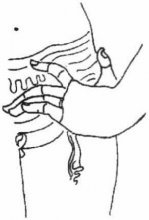Katisutra, Kaṭisūtra, Kati-sutra, Kaṭīsūtra, Kaṭisutra: 13 definitions
Introduction:
Katisutra means something in Hinduism, Sanskrit, the history of ancient India, Marathi. If you want to know the exact meaning, history, etymology or English translation of this term then check out the descriptions on this page. Add your comment or reference to a book if you want to contribute to this summary article.
Images (photo gallery)
In Hinduism
Shilpashastra (iconography)
Source: Wisdom Library: Śilpa-śāstraKaṭisūtra (कटिसूत्र) refers to “waist zones”.
Source: Shodhganga: Vaisnava Agamas And Visnu ImagesKaṭisūtra (कटिसूत्र) refers to a type of “decorative cord” (sūtra), as defined in treatises such as the Pāñcarātra, Pādmasaṃhitā and Vaikhānasa-āgamas, extensively dealing with the technical features of temple art, iconography and architecture in Vaishnavism.—Kaṭisūtra is a (simple or thin) thread worn around the waist. Sometimes it is beautified with pearls or gems. Kaṭibandha is a band or belt worn over the waist. It is supposed to hold the under-garment/robe, which is then tied or wrapped around it.

Shilpashastra (शिल्पशास्त्र, śilpaśāstra) represents the ancient Indian science (shastra) of creative arts (shilpa) such as sculpture, iconography and painting. Closely related to Vastushastra (architecture), they often share the same literature.
India history and geography
Source: Cologne Digital Sanskrit Dictionaries: Indian Epigraphical GlossaryKaṭī-sūtra.—(EI 16), an ornament. Note: kaṭī-sūtra is defined in the “Indian epigraphical glossary” as it can be found on ancient inscriptions commonly written in Sanskrit, Prakrit or Dravidian languages.
Source: Singhi Jain Series: Ratnaprabha-suri’s Kuvalayamala-katha (history)Kaṭisūtra (कटिसूत्र) refers to a type of ornament part of celebrations in ancient India of the “grand festival” (Mahotsava) of the coronation of a crown prince (yuvarāja-abhiṣeka), as depicted in the Kathās (narrative poems) such as Uddyotanasūri in his 8th-century Kuvalayamālā (a Prakrit Campū, similar to Kāvya poetry).—Page 199: Here is described yuvarāja-abhiṣeka-mahotsava when the city of Ayodhyā put on gala appearance by means of beautifying streets, [...] making offerings on the cross roads, beginning dramatic performances, hoisting of the lion banners, installing canopies, cloth pieces were being torn in proper pieces pālī for being wrapped round the post, pendants like the Kaṭisūtra ornaments were hung from the ceilings of doorways and walls of the houses, the great jewels were being taken out and put on show in the treasury [...]”.

The history of India traces the identification of countries, villages, towns and other regions of India, as well as mythology, zoology, royal dynasties, rulers, tribes, local festivities and traditions and regional languages. Ancient India enjoyed religious freedom and encourages the path of Dharma, a concept common to Buddhism, Hinduism, and Jainism.
Languages of India and abroad
Marathi-English dictionary
Source: DDSA: The Molesworth Marathi and English Dictionarykaṭisūtra (कटिसूत्र).—n (S) A silk cord, silver twist &c. worn around the loins.
Marathi is an Indo-European language having over 70 million native speakers people in (predominantly) Maharashtra India. Marathi, like many other Indo-Aryan languages, evolved from early forms of Prakrit, which itself is a subset of Sanskrit, one of the most ancient languages of the world.
Sanskrit dictionary
Source: DDSA: The practical Sanskrit-English dictionaryKaṭisūtra (कटिसूत्र) or Kaṭīsūtra (कटीसूत्र).—a zone or waistband.
Derivable forms: kaṭisūtram (कटिसूत्रम्), kaṭīsūtram (कटीसूत्रम्).
Kaṭisūtra is a Sanskrit compound consisting of the terms kaṭi and sūtra (सूत्र).
Source: Cologne Digital Sanskrit Dictionaries: Shabda-Sagara Sanskrit-English DictionaryKaṭisūtra (कटिसूत्र).—n.
(-traṃ) A female zone or waist-band. E. kaṭi the loins, and sūtra a thread.
Source: Cologne Digital Sanskrit Dictionaries: Benfey Sanskrit-English DictionaryKaṭisūtra (कटिसूत्र).—n. a zone, [Bhāgavata-Purāṇa, (ed. Burnouf.)] 5, 3, 4.
Kaṭisūtra is a Sanskrit compound consisting of the terms kaṭi and sūtra (सूत्र).
Source: Cologne Digital Sanskrit Dictionaries: Monier-Williams Sanskrit-English DictionaryKaṭisūtra (कटिसूत्र):—[=kaṭi-sūtra] [from kaṭi > kaṭ] n. a zone or waistband, girdle, [Bhāgavata-purāṇa; Pañcadaṇḍacchattra-prabandha]
Source: Cologne Digital Sanskrit Dictionaries: Yates Sanskrit-English DictionaryKaṭisūtra (कटिसूत्र):—(traṃ) 1. n. A female zone.
[Sanskrit to German]
Sanskrit, also spelled संस्कृतम् (saṃskṛtam), is an ancient language of India commonly seen as the grandmother of the Indo-European language family (even English!). Closely allied with Prakrit and Pali, Sanskrit is more exhaustive in both grammar and terms and has the most extensive collection of literature in the world, greatly surpassing its sister-languages Greek and Latin.
Kannada-English dictionary
Source: Alar: Kannada-English corpusKaṭisūtra (ಕಟಿಸೂತ್ರ):—
1) [noun] an ornamental metal band for the waist.
2) [noun] a thread for the waist.
Kannada is a Dravidian language (as opposed to the Indo-European language family) mainly spoken in the southwestern region of India.
See also (Relevant definitions)
Full-text (+1): Shronibimba, Katitra, Katibandha, Bandha, Sutra, Cross road, Great jewel, Wall, Canopy, Performance, Installing, Treasury, Dramatic performance, Hoisting, Lion banner, Doorway, Katihasta, Katyalambana, Mahotsava, Aghora.
Relevant text
Search found 7 books and stories containing Katisutra, Kaṭisūtra, Kati-sutra, Kaṭi-sūtra, Kaṭīsūtra, Kaṭī-sūtra, Kaṭisutra; (plurals include: Katisutras, Kaṭisūtras, sutras, sūtras, Kaṭīsūtras, Kaṭisutras). You can also click to the full overview containing English textual excerpts. Below are direct links for the most relevant articles:
Early Chola Temples (by S. R. Balasubrahmanyam)
Bronze, group 3: Age of Parantaka I (a.d. 907 - 950) < [Chapter XI - Sculpture]
Bronze, group 1: Late Pallava and Early Chola—Age of Vijayalaya (a.d. 785-871) < [Chapter XI - Sculpture]
Pallava period (Social and Cultural History) (by S. Krishnamurthy)
Waist Ornaments (Introduction) < [Chapter 4 - Material Culture of the People]
Waist-band (Kati-sutra) < [Chapter 4 - Material Culture of the People]
Dressing style of Children < [Chapter 4 - Material Culture of the People]
Garga Samhita (English) (by Danavir Goswami)
Verse 8.9.5 < [Chapter 9 - Lord Balarāma’s Rāsa Dance]
Cosmetics, Costumes and Ornaments in Ancient India (by Remadevi. O.)
2.7. Various other Waist Ornaments < [Chapter 3 - Ornaments]
Manasara (English translation) (by Prasanna Kumar Acharya)
Harshacharita (socio-cultural Study) (by Mrs. Nandita Sarmah)
Part 5: Different Stages of the Life or Āśrama Vyavasthā < [Chapter 2 - Caste System]
